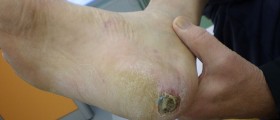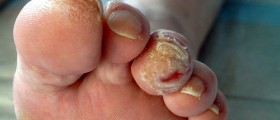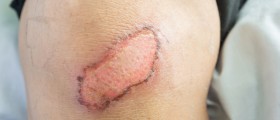
What Causes Diabetic Foot Pain?
Peripheral neuropathy is one of the most serious complications of diabetes. It can be further classified into sensory, motor and autonomic neuropathy. In many cases patients develop sensory diabetic neuropathy. Changes is one's sensitivity may be associated with excruciating pain even though the affected foot has only been slightly touched. Furthermore, some people have to deal with reduced sensation in their feet which makes them more susceptible to injuries. Motor diabetic neuropathy is responsible for muscle weakness and achy muscles. And finally, autonomic neuropathy is associated with dry, stiff and cracked skin and the risk of painful calluses.
Problem with circulation represents another common issue patients suffering from diabetes have to deal with. The affected blood vessels narrow due to atherosclerosis and certain parts of the body are not supplied with a sufficient amount of blood any more. This can cause intensive pain and additional damage to the affected structures.
Infections of the foot are typical for diabetic patients who have already developed neuropathy and circulatory problems. They easily contract bacterial of fungal infection and develop ulcers that heal slowly. The skin on the feet is dry, it lacks oxygen and there is a decrease in sensitivity. Prolonged friction is not identified as irritating but it may eventually cause damage to the skin and secondary bacterial or fungal infection which may eventually cause pain and many more problems.
And finally, diabetic foot pain may occur due to contractures and stiffness of the tendons.
Symptoms of Diabetic Foot Pain
As the very name suggests the leading symptom is pain in the foot/feet. The person may complain about a burning sensation or the pain occurs in a form of stabbing or tingling sensation. Pain is either intermittent or permanent. Apart from the pain the foot may be swollen and the skin red. In case one is suffering from motor neuropathy he/she will most definitely have walking and balance problems. Repeated fiction of the most susceptible parts of the foot eventually leads to formation of calluses and diabetic foot ulcers. Due to all the previously mentioned it is essential to identify the very beginning of all complications of diabetes that may eventually cause foot pain. This way treatment may prevent fast progression of the damage and may partially alleviate the pain in case it has already developed.

















Your thoughts on this
Loading...